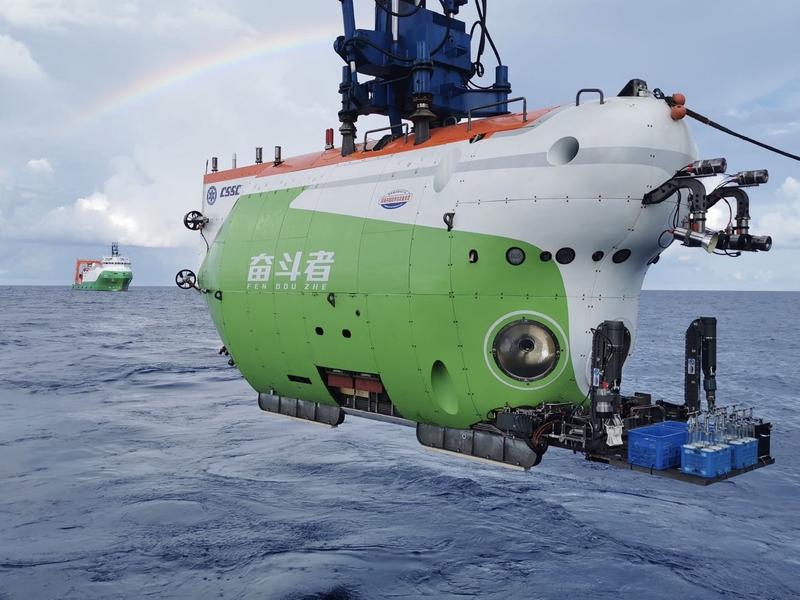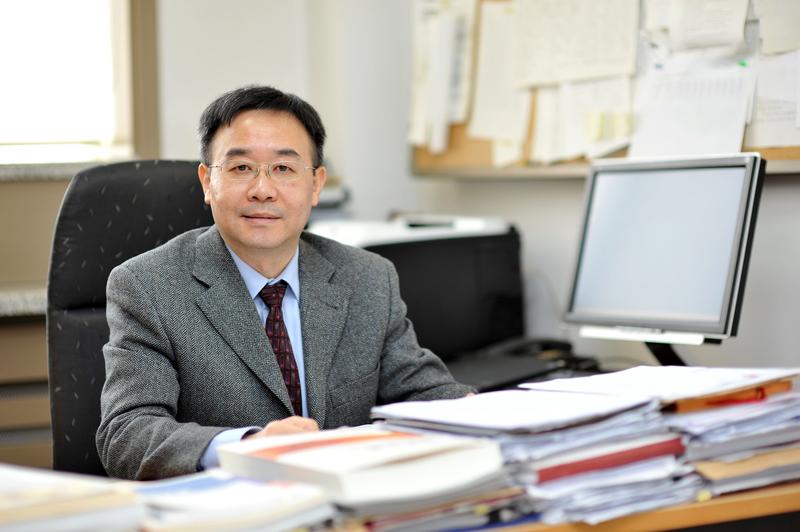Expert has contributed to some of China's extraordinary breakthroughs. Zhang Zhihao reports.
 The deep-sea manned submersible Fendouzhe (Striver in English), which set the national diving record of 10,909 meters in 2020, is lowered into the ocean in July last year. (PHOTO / XINHUA)
The deep-sea manned submersible Fendouzhe (Striver in English), which set the national diving record of 10,909 meters in 2020, is lowered into the ocean in July last year. (PHOTO / XINHUA)
Editor's note: To mark the 20th National Congress of the Communist Party of China, China Daily is producing 10 profile stories to show the changes in the subjects' fields in the past decade. This is the fourth of the series.
Within China's materials science community, colleagues often humorously refer to Yang Rui as the "hardest man" in the field. This is both a reference to his groundbreaking work on high-performance titanium alloys and an allusion to the extremely difficult missions that he and his team often undertake.
Over the past decade, the 57-year-old researcher from the Institute of Metal Research at the Chinese Academy of Sciences has provided critical components for many of China's most ambitious engineering feats.
Scientists discover new materials in labs all the time, but turning them into useful products that can be mass-produced can take a long time.
Yang Rui, researcher from the Institute of Metal Research at the Chinese Academy of Sciences
These have included the cryogenic engines that lifted the Long March 5, China's most powerful carrier rocket that is used to build the nation's new space station; the deep-sea manned submersible Fendouzhe (Striver in English), which set the national diving depth record of 10,909 meters in 2020; and the Changjiang-1000 turbofan jet engine for the COMAC C919, China's first homemade passenger jet.
Seeing his work being used in so many instruments of national significance, Yang said a single phrase best captures his feelings about these accomplishments: "At least I did not live my life in vain."
In fact, Yang is immensely proud.
"Doing materials science and engineering is very difficult work, punctuated by constant challenges and failures," he said. "But when the materials you have worked so hard on finally get put into good use, the joy at the end is incredible."
Critical materials
After completing his doctorate at the University of Cambridge in the United Kingdom in 1992 and undertaking a three-year postdoctoral fellowship at the university's St John's College, Yang returned home in 1995 to become a researcher at the Institute at CASS.
"My area of expertise is novel titanium alloys. But when I first returned home, China had no equipment, industrial capacity or applications for such an advanced material," he said.
Despite the significant technical gap between China and the UK, Yang said his decision to return was correct because he witnessed how the reform and opening-up policy unleashed China's economic and industrial potential.
"China is very rich in titanium, holding around 41 percent of the world's total reserves," he said. "China's high-end industries, such as aerospace and aviation, were also taking off, so I knew that there would be a demand for advanced materials eventually."
Titanium alloys are high in strength, light and have excellent resistance to heat and corrosion. They have been used in aerospace engines, rockets, missiles, transportation, power generation, medical implants and chemical industries.
Despite being the ninth most abundant element in the Earth's crust, titanium is a very costly material compared with aluminum and steel due to the metal being notoriously difficult to refine and machine, Yang said.
One of his biggest scientific achievements was the creation of a metal casting mold with a special yttrium oxide coating that can effectively produce titanium-aluminum alloy turbine blades for aero engines without the need for additional machining, which translates to lower manufacturing costs.
The new blades are also lighter than their nickel alloy counterparts, and thus more fuel efficient.
"Scientists discover new materials in labs all the time, but turning them into useful products that can be mass-produced can take a long time," he said, adding that it typically takes about 30 years to create a new generation of aero engines, 20 of which are used to find and develop the right materials.
"This is because we have to make sure these critical materials are absolutely safe and reliable, as even a minor flaw can be catastrophic."
 Yang Rui, researcher from the Institute of Metal Research at the Chinese Academy of Sciences. (PHOTO PROVIDED TO CHINA DAILY)
Yang Rui, researcher from the Institute of Metal Research at the Chinese Academy of Sciences. (PHOTO PROVIDED TO CHINA DAILY)
Unwavering persistence
Yang said that over the past two decades, China's materials science and engineering sector has seen major growth, with the first decade laying a solid foundation. However, the last 10 have really seen China emerge as a global science and technology powerhouse, characterized by many original breakthroughs.
"The recent progress has really made us confident and proud of our country and culture," he said.
The Chinese character for device or instrument is qi, which consists of four squares in each corner with the radical for a dog in the middle. Yang finds this ancient character, which dates back to the Shang Dynasty (c. 16th-11th century BC) surprisingly relevant to today's materials scientists and engineers.
"The four squares represent the four main applications of titanium alloys: aerospace, aviation, shipbuilding and weapons manufacturing. We (the scientists) are like the dog in the middle, pursuing innovation with tenacious and unwavering persistence," he said.
When making the YF-77 cryogenic engine that was used in the Long March 5 rocket, Yang was tasked with creating the hydrogen pump impeller, a critical component that feeds the combustion chamber with liquid hydrogen fuel to be mixed with liquid oxygen and ignited to provide thrust.
"An interesting fact about the critical component is that it may be a small part of the larger equipment, but it can make or break the entire project," Yang said. In the case of YF-77 engine, the turbo pump impeller needs to reliably operate under high pressure and at-253 C.
However, making this impeller was relatively easy compared with Yang's next big project: creating the crew chamber for the Fendouzhe deep-sea manned submersible that can withstand the extreme water pressure in the deepest parts of the ocean.
"The challenge was that we were not just creating a small part, but a one-of-a-kind giant metal ball that would safely carry three crew members as they descended more than 10 kilometers below the surface of the ocean," he said.
Innovative techniques
To make the crew chamber, Yang and his team, along with researchers from more than 10 other institutions, developed a new titanium alloy called Ti-62A and a new welding technique that does not use rivets and bolts, thus reducing the weight of the structure.
"We didn't have the chance for trial and error. The pressure on the team was immense, but at the same time we were more motivated than ever," Yang said, referring to crucial budgetary and time constraints.
In the face of monumental obstacles, he said it is important to have a deep understanding of basic science and the materials' properties, and maintain a positive attitude and be open to advice and collaboration.
In the end, the submersible touched down in the Challenger Deep, the deepest known part of the (Western Pacific) ocean, on Nov 10, 2020. The feat proved that China had acquired "full ocean depth capability", meaning that it can carry out routine manned expeditions and scientific exploration at any depth in any ocean.
"It took thousands of Chinese scientists and engineers to make Fendouzhe possible," Yang said. "In a sense, we are all strivers for greatness."
Contact the writer at zhangzhihao@chinadaily.com.cn



